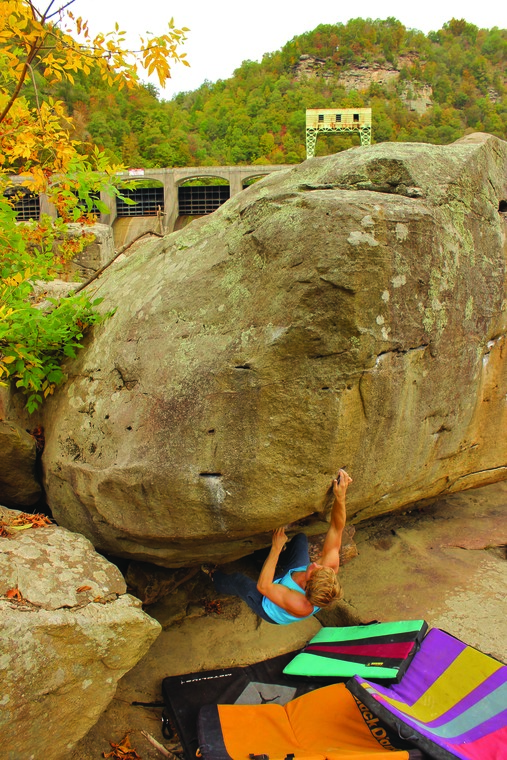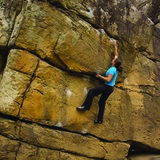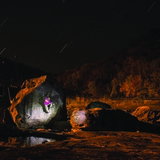Hawk's Nest is historically the most famous bouldering area at the New River Gorge, due to its unique and enjoyable setting on the big flat rock platform, at the base of the dam. The setting creates a great open western feel that is perfect for cold days and it makes it easy to move from boulder to boulder and enjoy good rock and flat landings. Many locals feel that Hawk's Nest is a bit lacking in quantity of stand-out line, but there are now two newer zones (Lower Hawk's Nest and Hawk's Nest Left - recorded as a different crag due to a different hike in) that have no shortage of big proud lines. You do however trade the luxury of the giant rock platform setting when visiting the boulders at Lower Hawk's Nest and Hawk's Nest Left.
🚶♂️ Approach summary - Mellow, about 20 minutes, mostly on a well maintained gravel road.
💎 Notable problems - "Pucker Face" V2, "Egg Direct" V3, "Leaving Las Fayetteville" V4, "Elephant in the Room" V5, "Was That A Boob?" V6, "Fall From Grace" V6, "Immaculate Connection" V7, "White Eyebrow" V7, "California Condor" V8
💧 Dry time - Hours. Extremely quickly for most boulders. No additional wait time needed once rock is visibly dry.
🍂❄️🍃 Seasonal Beta - Best fall to spring, it is warm on the river in the summer. This area melts very quickly from snow.
🌊 Water Level Beta - Highly water dependent, see below.
🚗 Drive from downtown Fayetteville - 10 minutes
🚗 Drive from Summersville - 35 minutes
🚽 Bathrooms - None currently. Possible installation of pit toilets in the parking eventually.
📶 Cell phone service - 3/5, variable.
🐶 Dogs - Are allowed. Consider keeping your dog leashed as this area is frequented by non-climbers.
*Climbing at Hawk's Nest is water level dependent! Look at the website linked below. The lowest possible water level has raised in the past few years due to an environmental study done to determine if raising the minimum flow would be better for the flora and fauna. It used to be below 4ft, but now the minimum level is 4.35ft.
-If you ever catch the water level BELOW 4ft, everything will be climbable.
-At 4.35ft many problems will need a landing build for them, as they now sit in a few inches of water. Some notable problems that are no longer accessible due to this minimum flow raise are the Black Pocket Problem Boulder, Brass Knuckles, Orange at Lower Hawk's Nest, and the wade across the river to Hawk's Nest Left has become impassible.
Water level below the Hawks Nest Dam: https://waterdata.usgs.gov/monitoring-location/380649081083301/
What to Do if the Dam Siren Sounds:
Don't Panic (Midwesterners: it's not a tornado). When the siren goes off it means that they will open up the dam. Maybe. If they do, it will happen 5 minutes after the siren ENDS. Notice all the little gates in the dam. When they open the dam all they do is raise one of these gates about a foot.The giant doors make a clicking sound as they are slowly hauled up. As water starts to come through, the river level gradually rises. If you are working something right at the edge of the water, calmly move to a different boulder. If the siren sounds again, they will open the gate further or open up a different gate. Just pick a boulder that has a higher elevation or pick a different boulderfield if the water level starts getting too high.
***Please note that this is not true every time. Someday the person monitoring the water levels above the dam may fall asleep or something and wake up to find too much water behind the dam. Then who knows, maybe they'll open a door all the way without warning. Maybe the dam will explode. Just be smart. If you hear an unidentified loud clicking noise and/or notice water coming out from a gate, gather your things and back up from the edge of the water.









